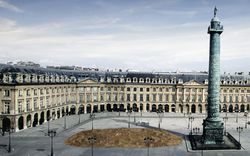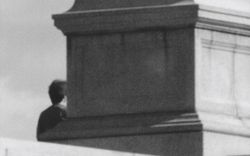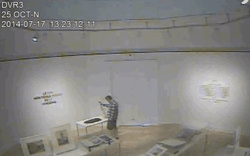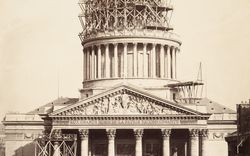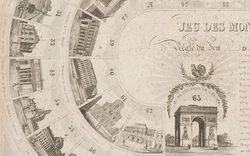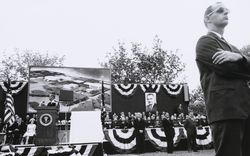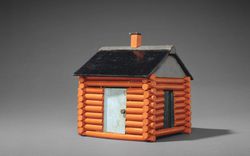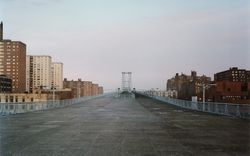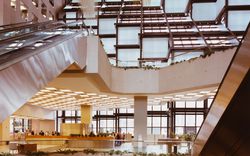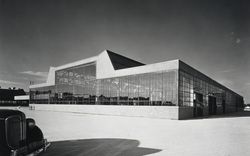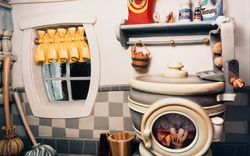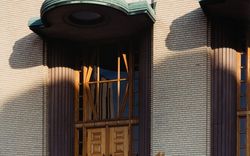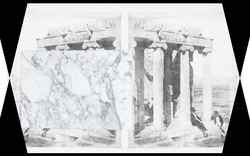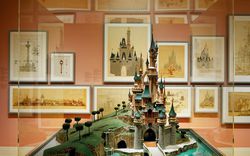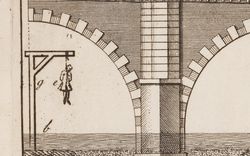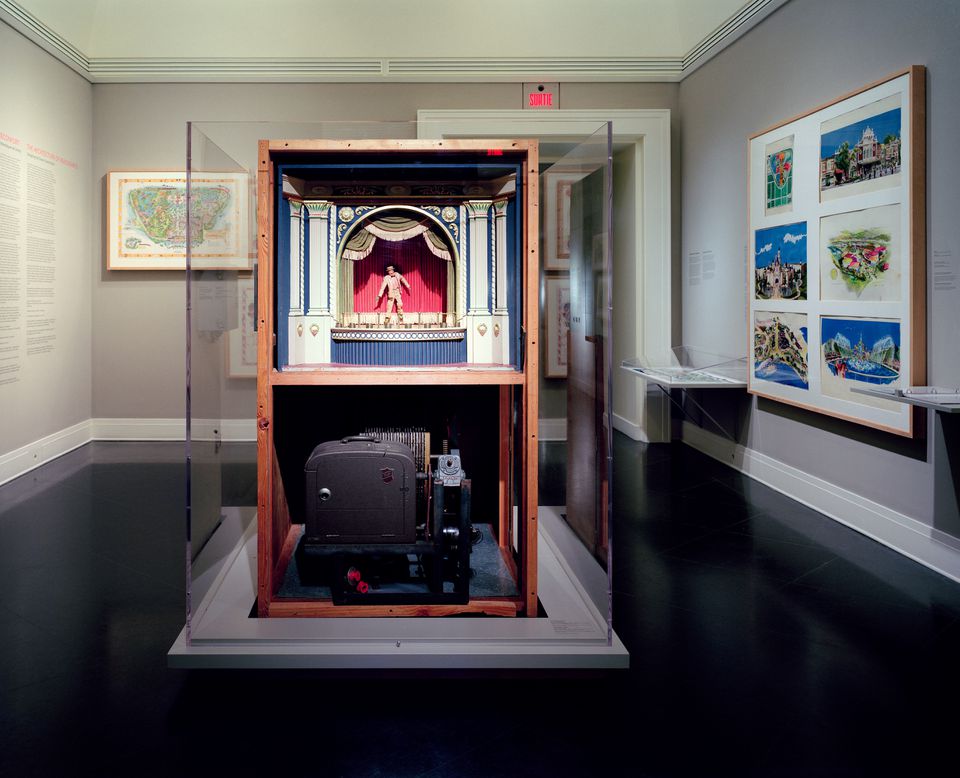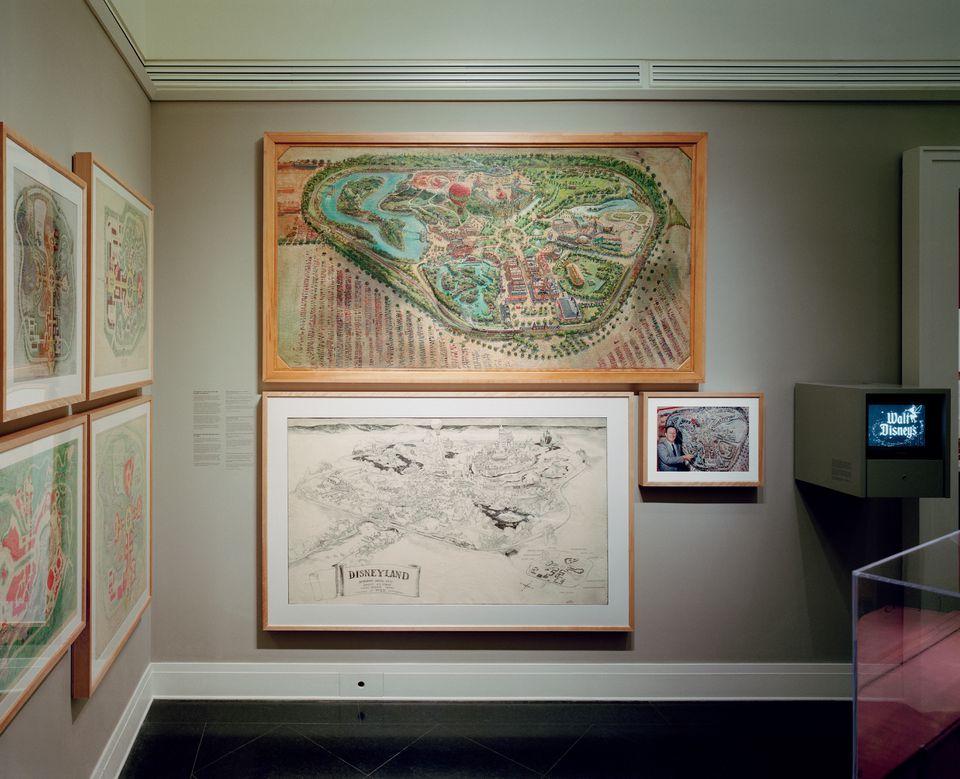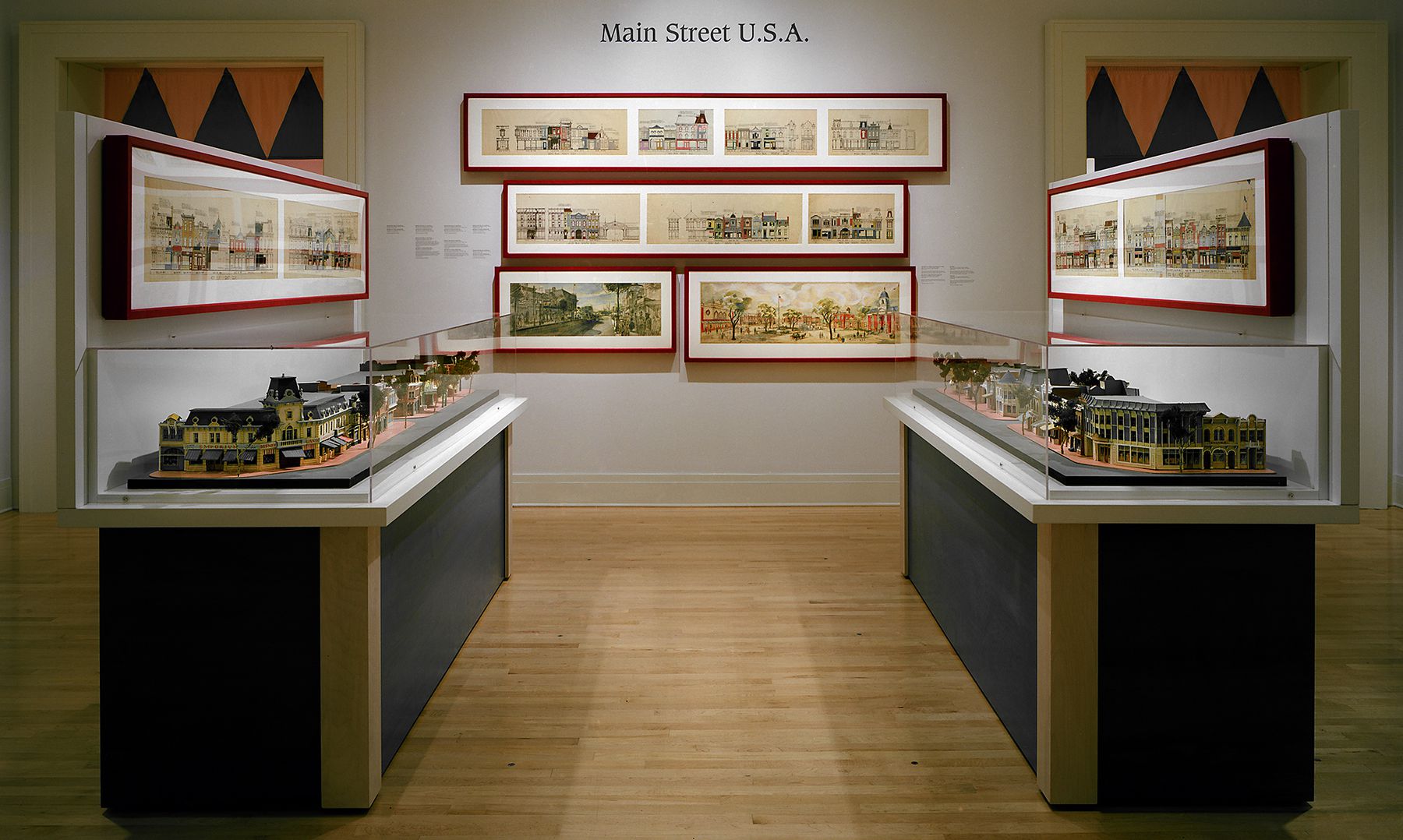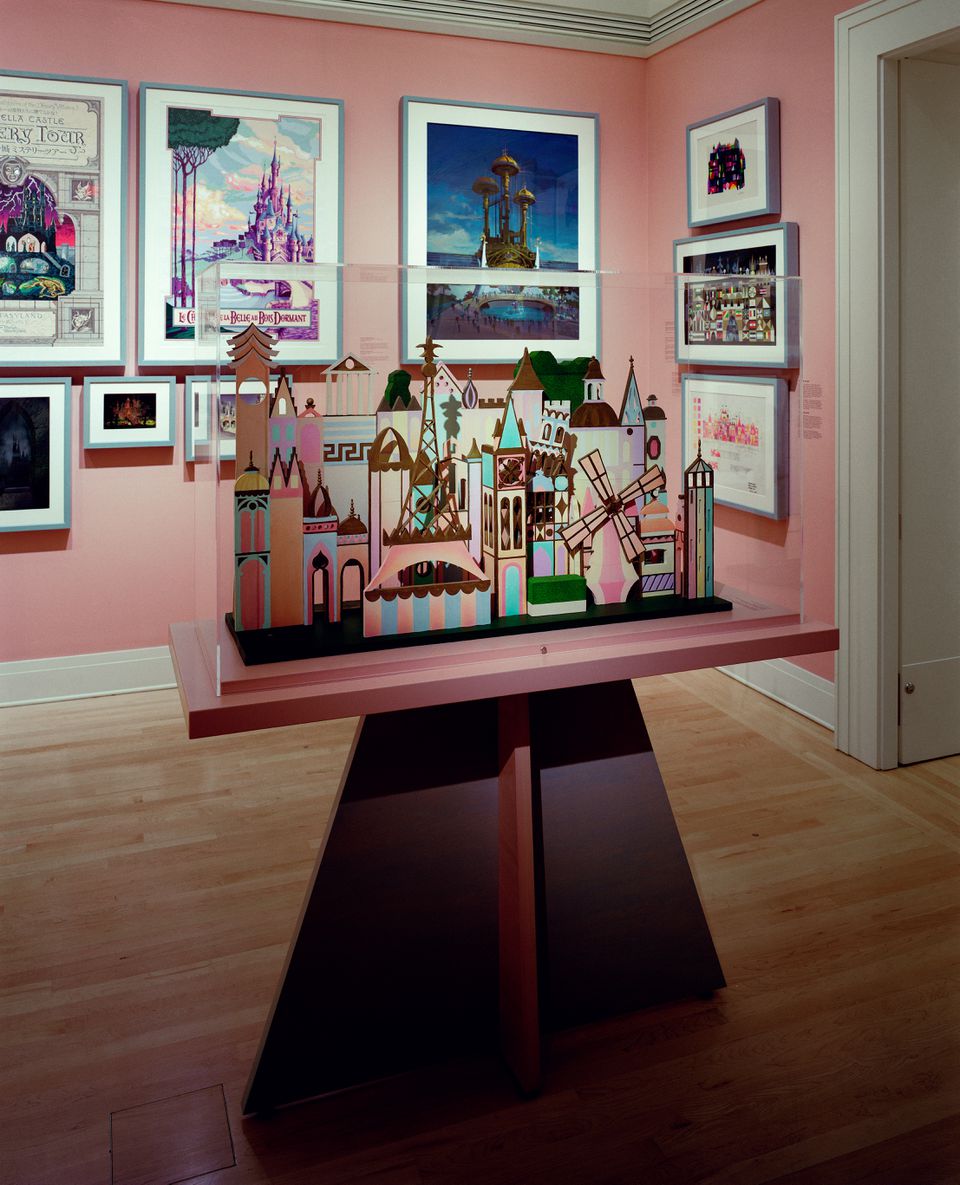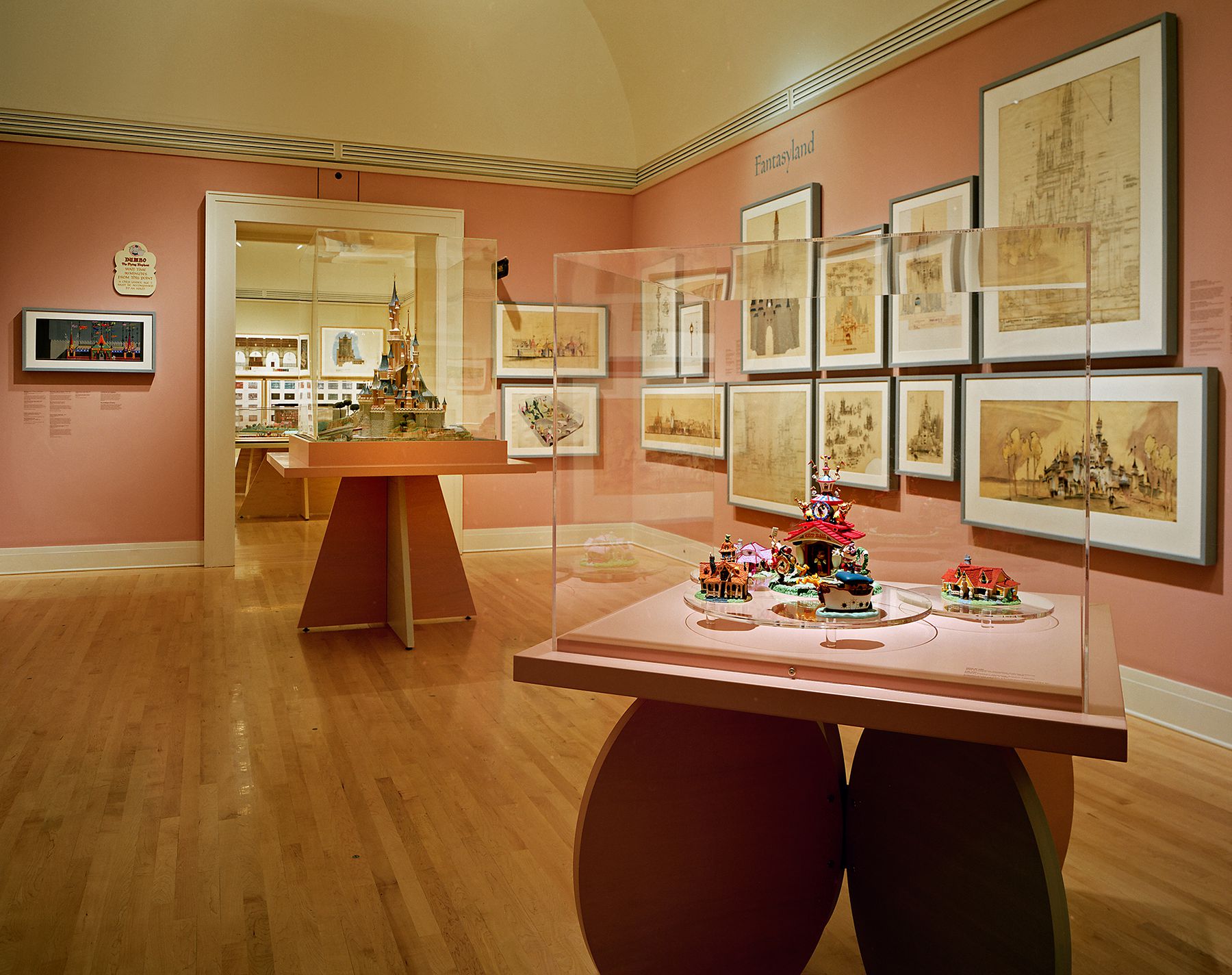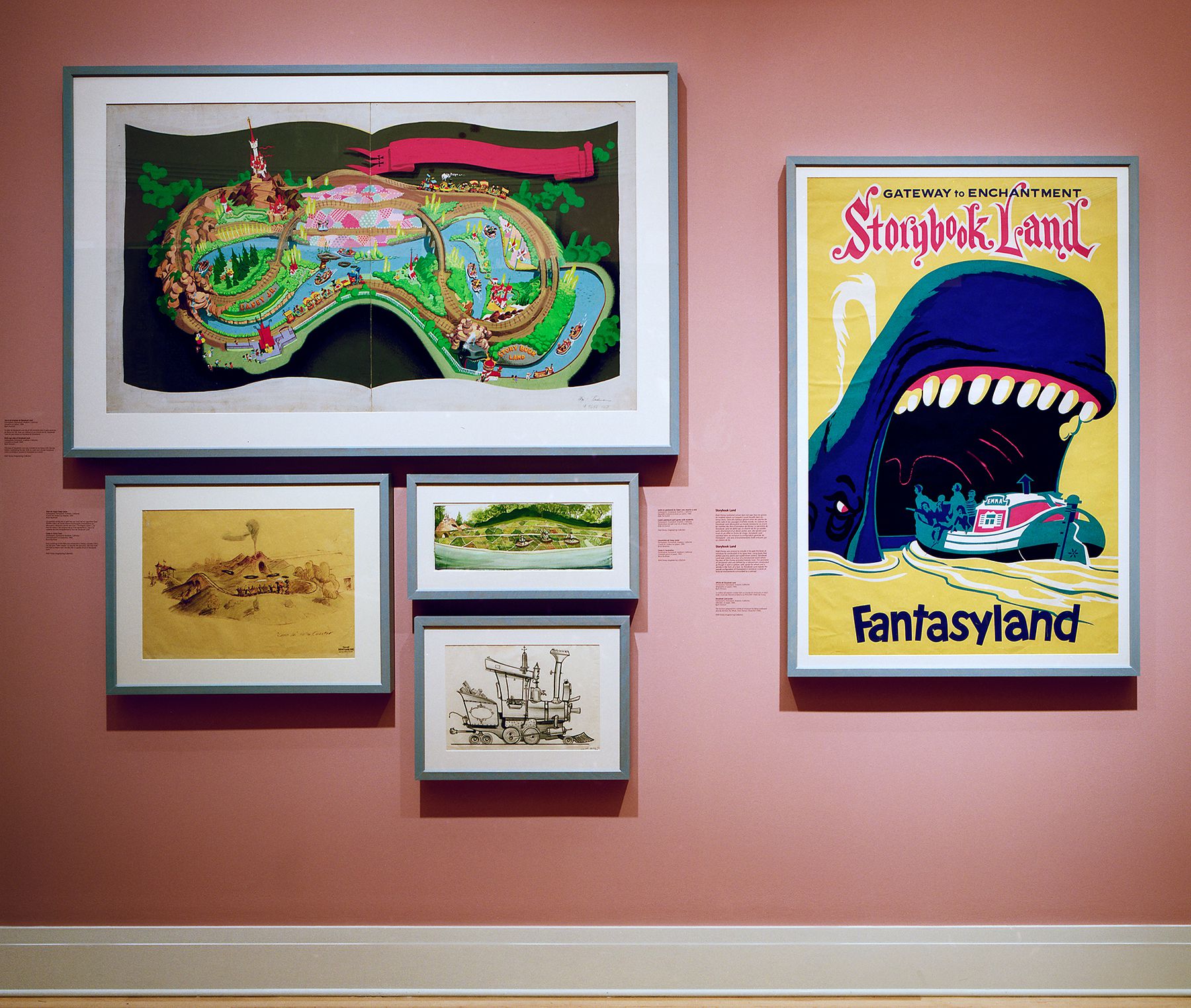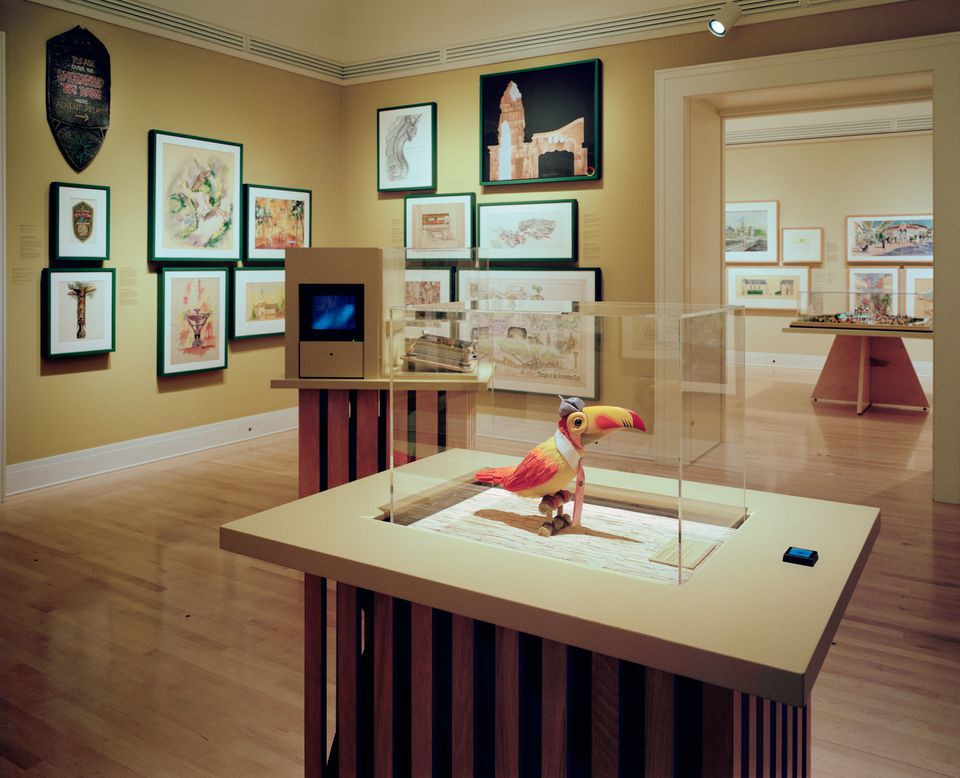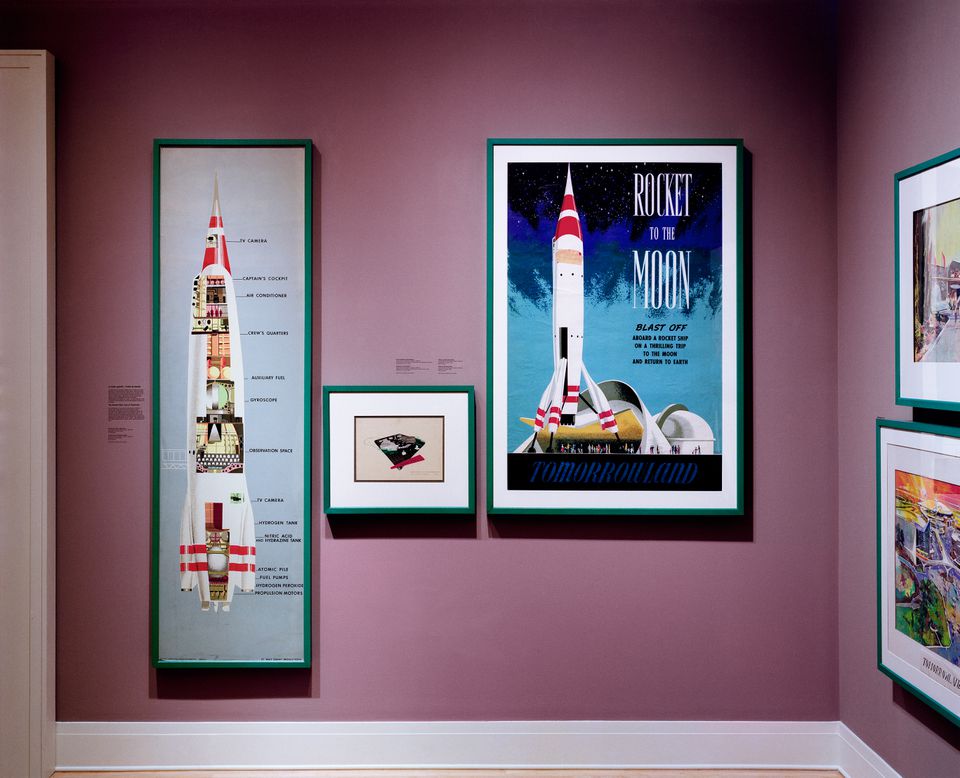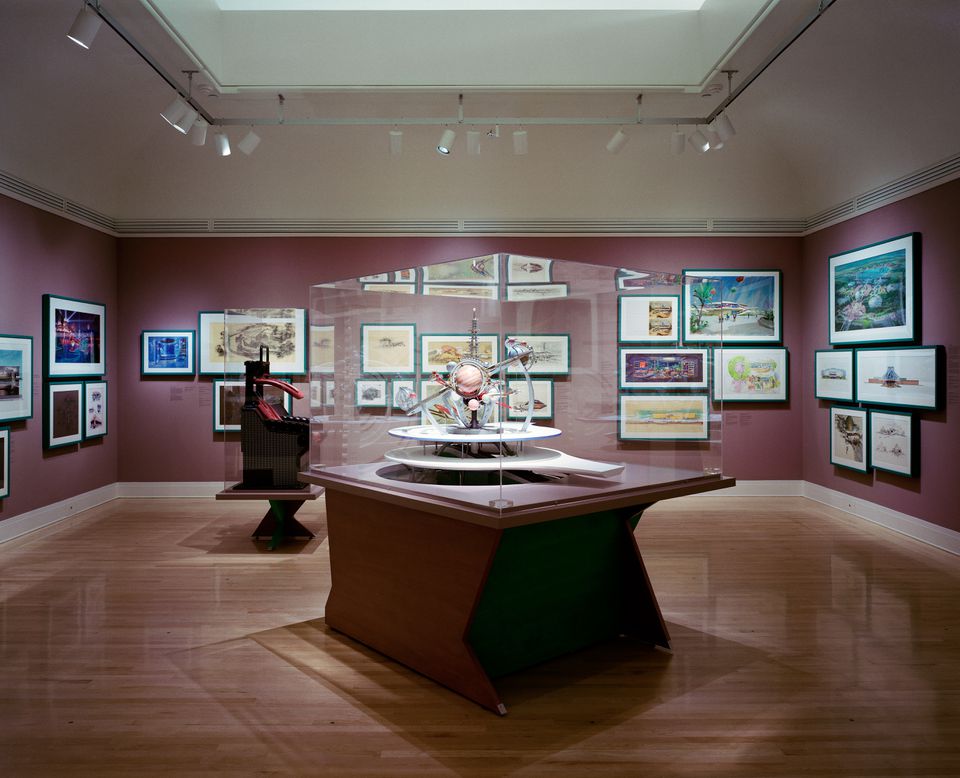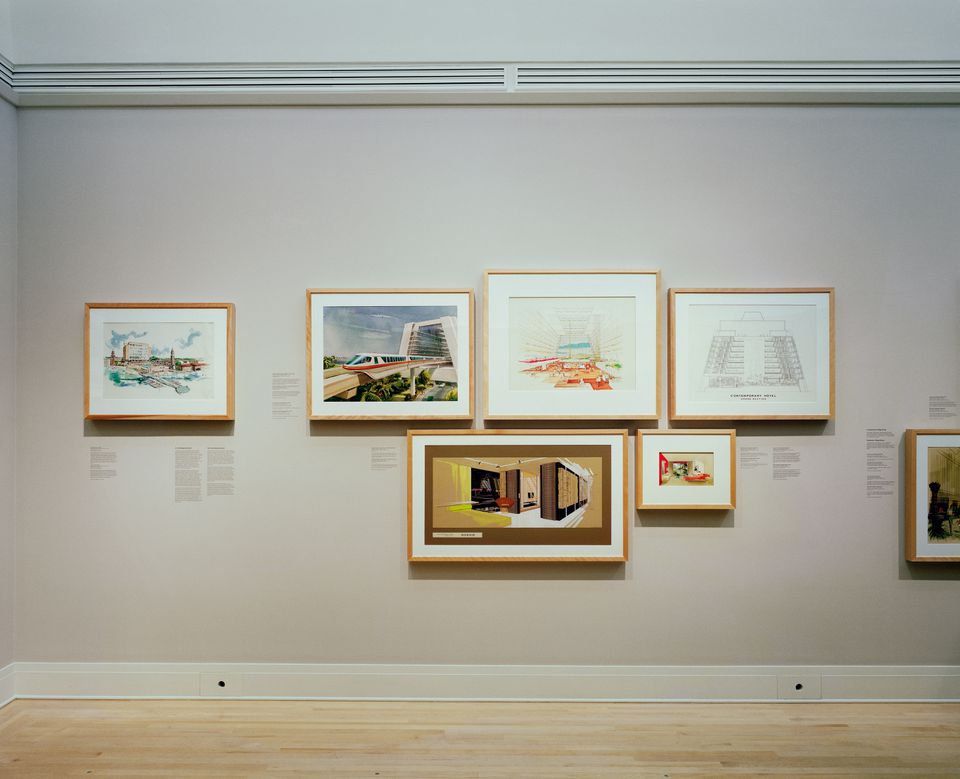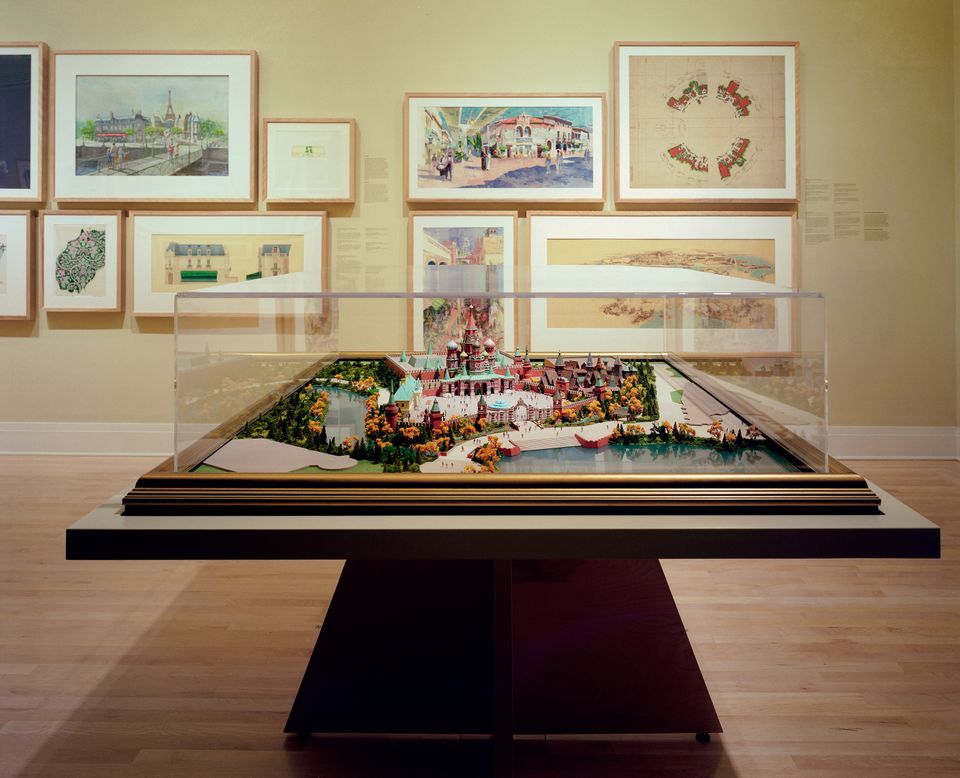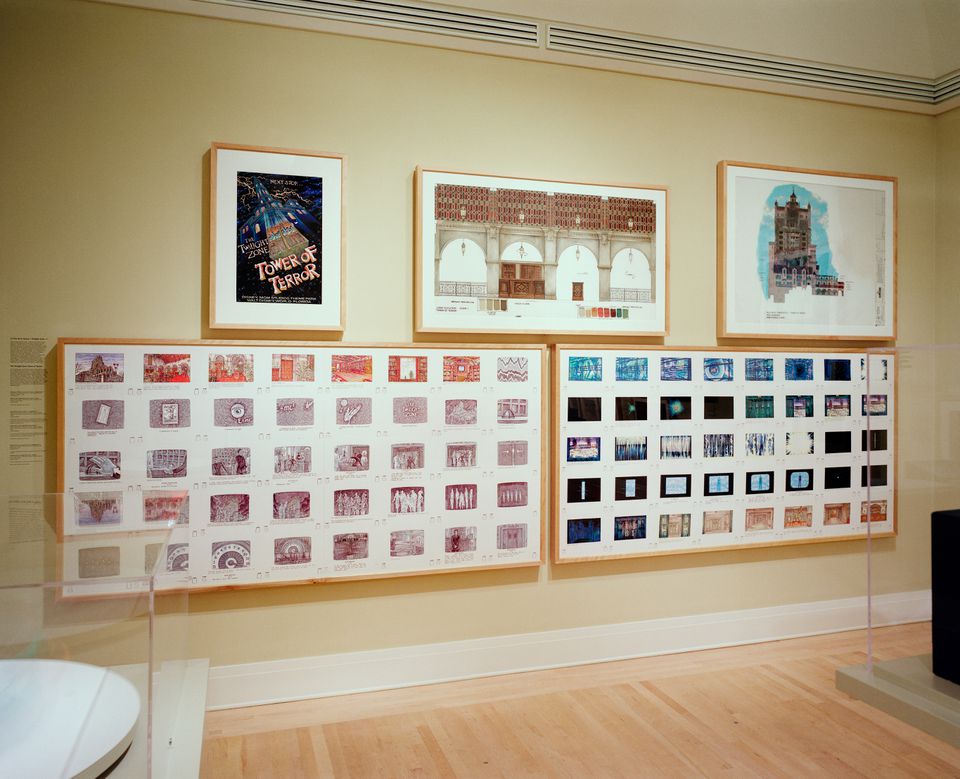Touring the Architecture of Reassurance
Excerpts of an audioguide by Karal Ann Marling
Hi! I’m Karal Ann Marling, curator of the exhibition. On this audio tour, I will accompany you through The Architecture of Reassurance: Building the Disney Theme Parks. The object of this exhibition is to demonstrate how it was that Walt Disney came to build Disneyland and his other theme parks.
Primarily, Walt was dissatisfied with Los Angeles and with other American cities of his era, the 1940s and 1950s. He was dissatisfied because the American city, it seemed to him, had become an utterly chaotic environment: cars rocketing here and there, unplanned suburbs, no sense of visual coherence, no sense of safety and reassurance. Walt Disney was also interested, however, in theming. Specifically, he was interested in what the American city had been in the past, the frontier West, the life of the small town as he remembered it at the turning of the century. He was interested finally, I think, in creating a place where people could feel safe and reassured.
We call this exhibition “The Architecture of Reassurance” because at every point in the design of Disney’s theme parks you feel safe, secure—you feel as though you know where you are in space.
Dancing Man Machine
In the late 1930s Walt Disney became interested in what we could call a form of three-dimensional animation: little figures that actually moved—robotic figures. This became the core of what he called “Disneylandia,” a project in which a group of miniature environments occupied by robotic figures would travel around the United States in railroad cars. You’d put a quarter in a slot, and the little dancing man would perform for you. The technical problems with such miniatures were overwhelming, however, and Walt shelved the project for later use. It was revived in the 1960s in what we nowadays call Audio-Animatronics, or moving figures that enliven many Disney attractions.
Maps of Disneyland
In many ways, Disneyland was a product of the television age. In order to secure financing for his park, Walt’s brother Roy took Herbert Ryman’s plan to New York and used it to persuade ABC Television, then in third place among the networks, to finance Disneyland. Walt then appeared every Wednesday night on a show called Disneyland, discussing a park that had yet to be built. But people, of course, were convinced that it really existed, and they were convinced by graphics like this that made the place absolutely real. There wasn’t a child in America by the end of 1954 and the beginning of 1955 who did not have a map of Disneyland imprinted on his or her imagination, and with that map all the constituent parts of Disneyland: Frontierland, which reflected Walt’s popular series called Davy Crockett; Adventureland, which reflected his popular true-life adventure/nature films; Fantasyland, which mirrored the content of Disney’s cartoon feature films; and Tomorrowland, which predicted what the future was going to look like and employed special effects, like those used in Disney’s 20,000 Leagues Under the Sea.
Main Street U.S.A. Model
In all the Disney theme parks, after the common entry point—the ticket booths—comes Main Street U.S.A. It expresses, of course, something of Walt’s nostalgia for Marceline, Missouri, around the turning of the century. It shows a small town in America on the very brink of modernization: electricity, automobiles, and horse carts, all on the same street.
But it is a commercial district too. Plans exist for a butcher shop, a shoe store, a newspaper. It was a kind of ideal town, but not a commercial strip in the sense that the 1950s meant that phrase. It’s not a place filled with “look at me” ads and architecture in which one building competes with another for attention. Instead, this is an integrated, well-planned streetscape designed to make the visitor feel comfortable.
Although Main Street is an integral part of every one of the Disney theme parks, it changes. It looks different depending on whether we’re in Florida, in Tokyo, or in Paris. In Florida, for example, planners anticipated much larger crowds. So, Main Street U.S.A. is built at a larger scale, with a wider street. They anticipated a brighter, flatter sunlight, so there needed to be more architectural detail, depth, brightness of color. In Tokyo where the climate is rainy a great deal of the year, Main Street was enclosed, roofed over with an 1890s iron and glass roof, like a train shed or a World’s Fair exhibition hall. For Main Street in Paris, designers presumed that Europeans knew America mainly through things they saw in the movies, like the famous “painted lady” houses of San Francisco, so colourful detail became the motif of Main Street in Paris.
Sleeping Beauty Castle, Disneyland Paris
Walt used the term “wienies” or “hot dogs,” by which he meant a sort of visual treat, something sizzling in the distance, a tall vertical element toward which a visitor could walk—something that articulated space, that allowed you to orient yourself to always know where you were. So he scattered prominent monuments all over the park. I think Walt got this idea from Paris, where monuments in the centres of roundabouts were a common element in city planning. The biggest wienie of them all, of course, is the castle. There’s a castle in every Disney theme park; it’s become the trademark of the company.
Just as there are different Main Streets for each of the different parks, so there are different castles for each park. In Paris Disneyland this presented a particular problem. Europe already has castles, of course. How can you outdo Europe in that respect? So, Disney’s Imagineers borrowed a little bit from here, a little bit from there—pieces of Mont St. Michel, pieces from illustrations in Les Tres Riches Heures du Duc de Berry, pieces of Disney’s animated features—and came up with this fanciful, organic view of what a castle should look like.
Model for Facade, It’s a Small World, Paris
Imagination plus engineering equals Imagineering, and Walt Disney’s crew of Imagineers designed It’s a Small World for the New York World’s Fair of 1964 for the Pepsi-Cola pavilion. What’s interesting about It’s a Small World is the abstract treatment of architectural landmarks: bits of the Eiffel Tower and the Leaning Tower of Pisa, all treated in a kind of flat, cubistic way, which contrasts markedly with the realism with which architectural environments are copied in other parts of the Disney parks.
Mickey’s Toontown
Toontown was built to answer that eternal question: where does Mickey Mouse really live anyway? The Imagineers tried, in Toontown, to build a house that looked like it might have come from a cartoon. That meant no right angles; that meant the boldest forms; that meant chimneys that leaned at strange angles. So it became necessary to bring small models of Mickey’s house to the construction site in order to show conventional contractors how to build a wholly unconventional house.
Storybook Land
Storybook Land is a kind of miniature version of the whole of the Disneyland park, reflecting Walt’s ongoing interest in miniatures. The little houses and the little castles are all copied from famous Disney films.
Enchanted Tiki Room
One of Walt’s many ideas for “plussing,” or continually updating, Main Street was to add a Chinatown district, with a Chinese restaurant. Food is, of course, a crucial experience in the Disney theme parks. Eating, like shopping, creates a sense of intimacy with the architectural environment.
During the course of developing new attractions for the 1964 World’s Fair, Walt Disney had also gone back to some of his earliest experiments with mechanical robotic technologies—the old dancing man attraction—and recycled it in the form of what he called Audio-Animatronics; that is, figures that were powered by compressed air and moved in sync with a recorded tape.
Halfway through the development of the Enchanted Tiki Room, Walt decided that Chinese food was out, and entertainment was in, particularly Polynesian entertainment. Polynesia—thanks to Elvis movies, Hawaiian statehood, Trader Vic’s, and Don the Beachcomber— was a hot motif in the United States in the fifties and sixties. So Walt plussed his original concept, changed it, improved it. Now the Tiki Room was going to be a show. And what a show! The very architecture was going to move and sing—talking architecture comes true!
Cutaway View of Moon Rocket
The Moon Rocket is Tomorrowland’s wienie. The first Tomorrowland built in 1954 reflected Americans’ optimism about what space was going to be like, the kind of optimism that prompted JFK in the early 1960s to call for a landing on the moon. But Tomorrowland was always a problem for Walt Disney and the Imagineers. Why? Because tomorrow always came, and it didn’t look like the Disney version. Tomorrowland was in a constant process of revision.
Working Model of Astro Orbiter
The final solution to Tomorrowland’s problem was to make the future look like the past thought it ought to. This takes many forms. At Discoveryland in Paris, the great thinkers of the past and their visions of the future are what counts. We see the future through the eyes of Jules Verne, H. G. Wells, Leonardo da Vinci. At Tomorrowland in Florida we see a kind of “gee whiz” retro, a 1940s and 1950s look at what the future is going to be like: lava lamps form columns, mechanical palm trees pop open when it gets sunny. These new solutions make Tomorrowland reassuring again.
Contemporary Hotel
The hotels at Walt Disney World were real buildings. Disney hired Welton Becket as a consultant and persuaded United States Steel to erect a temporary factory on the site in Florida. The factory turned out prefabricated rooms. These rooms were then slotted into place by cranes in an A-frame structure very similar to the atrium hotels created in this same era by John Portman. All you had to do to change the Contemporary Hotel to the Polynesian Hotel was to add theming or detailing in the decoration of the rooms.
The Monorail runs straight through the lobby of the hotel. Rumour has it that was Walt’s idea. It was to add drama to an otherwise fairly dull architectural conception. Welton Becket, they say, was furious.
Russian Pavilion, Epcot
The Soviet Union always posed a problem for Disney’s Imagineers. This was a part of the world noticeably absent from Epcot’s World Showcase. But after the Berlin Wall came down, Disney began pitching its notions of a Russian pavilion to sponsors within the former Soviet Union. They did so through a series of drawings and models that could be described as “blue sky” or imaginary ideal visions of what such an unbuilt pavilion would look like. Like Walt showing what his unbuilt Disneyland looked like on television in the 1950s, the Imagineers created a kind of unbuilt Russia, a combination of Red Square, St. Petersburg, and Tatlin’s monument to the Third International, well-known architectural references from that part of the world. An elaborate model for the Russian pavilion was also built, although, unfortunately, Russia never was.
Storyboard for Tower of Terror
This ride was planned just like a film, with a series of elaborate storyboards. Here, as in the Indiana Jones ride, the adventure is architecture. As we move through an elaborate setting, an old hotel with a ruined garden, a dusty lobby, a cree-ee-py library, and finally, a very 1990s thrill ride—a plummeting freight elevator that drops us from the top of the building to the bottom in a matter of seconds. Like Disney’s older attractions, this one is based on the movies, specifically a kind of film noir atmosphere, or the atmosphere of a Rod Serling show on television. The difference is that this place gives you the creeps—it’s not reassuring at all.
This text is adapted from an audioguide read by Marling, the curator of our exhibition The Architecture of Reassurance: Designing the Disney Theme Parks. The exhibition was on view here from June to September 1997; it later travelled to Minneapolis, New York, Fort Worth, Pittsburgh, and Kansas City.
